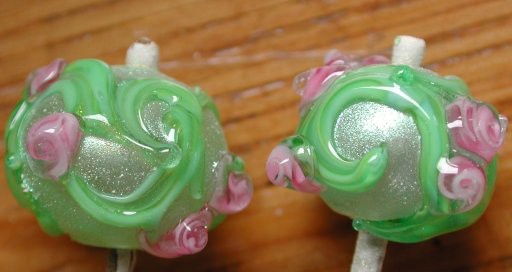I was exhausted and had a splitting headache when I made these. I didn't really know what to do, so I took some shorts and made a leaf cane of medium opaque turquoise ribbed on white, pea or nile green ribbed on the turquoise, and filled in (cased) with grass green. It wasn't very exciting, so having admired all the flowers—both in the beadwork and outside my window—I decided to make some little bracelet sized rounds with it. I wanted something vaguely curliQ like.
So I stuck some light transparent shorts together (to use them up—whenever I don't know what to do I fall back on this ‘let's use this up’ theme of mine) and coated them with pixie dust so the rather softly colored leaf cane wouldn't completely blend in with the background.
Originally I had the idea of very fine, very tight curliQs. One of the comments Jennifer Geldard made in a class I took earlier this year that I keep returning to, or keeps returning to me is ‘Only your mistakes are truly your own.’ In this case, I tried making the vines with the thickened end from the pull—and rather liked the effect, the opposite of what I'd originally intended: the vines became sheet-like.

Two favorites, with the ‘sheet’ shaped trailing. Though they seemed hugely different when I made them, really all of these beads look remarkably similar as a group.
Eventually I concluded I should've made flat ribbon cane for this project. Not at all exciting; and the the blown hilights are annoying (but those should be going away, when I get my new camera—I'm a lot more accepting of them now that I consider them a failure of the camera, rather than my technique [which if it were better would remind me to stop the camera down to cope with this problem, of course.]) Well, the point is to live and learn....
The irony, of course, is that shown these beads ten years ago—just a year before I started learning glass beadmaking—I would've been thrilled with them, and I think, with some justification, so would've a lot of other beadworkers. We've become a great deal more educated in the 30 years since the art-glass bead movement took off, particularly the last half of that period. For many years I used to make the comment “American bead makers are the best in the world.”
That was back when I was proud to be a United States citizen, which hasn't been true for a period of time that, to my sorrow, can now be measured in years. The SGB is now the ISGB and the movement started by a few disparate folks—perhaps 30, according to one old timer (Kate Drew Wilkerson, in a quite interesting review on GlassTalk radio); now, according to the same source, perhaps as many as 70,000 people have tried making beads. And there are fabulous beadmakers from all over the world who come to the annual ISGB conference and share their knowledge.
In some ways, that statement may never have been true: the Japanese have an extraordinary history of making glass bead objime (netsuke were used as a sash, or obi stop, but a second perforated object, ojime, kept the cord, or kumi, snug against the lid of the inro, or box) and there is also the famed African kiffa beads, which, unlike those of Japanese origins, I've only seen in pictures and certainly don't own.
Compared to the production style Italian and Bohemian lampwound beads, however, lampworked beads coming out of the American art-glass bead movement certainly have displayed an extraordinary rampup of skill and diversity in the last 30 years. That was the part of the statement that was important to me when I made it and the part that I wish to emphasize: those early American beadmakers shared their knowledge, in contrast to the traditionally closed, guild-like bead making cultures in Europe.
As a result, American beadmakers were able to acquire the basic skills quickly, and branch out in all sorts of startling ways; moreover, crossed with exploding communications technology, these early beadmakers not only exported their knowledge but their ethos, and now (for the most part) glass beadmaking worldwide is a culture that celebrates the sharing of knowledge and techniques. I'm very proud to be a part of that, and it's my excuse to show what I know—maybe it's not much nor very exciting, but it all accretes, and perhaps someone else will come up with some extraordinary variation upon my mundane efforts.
Effetre beads, 29apr05. File created 30apr05
Unless otherwise noted, text, image and objects depicted therein copyright 1996--present sylvus tarn.
Sylvus Tarn